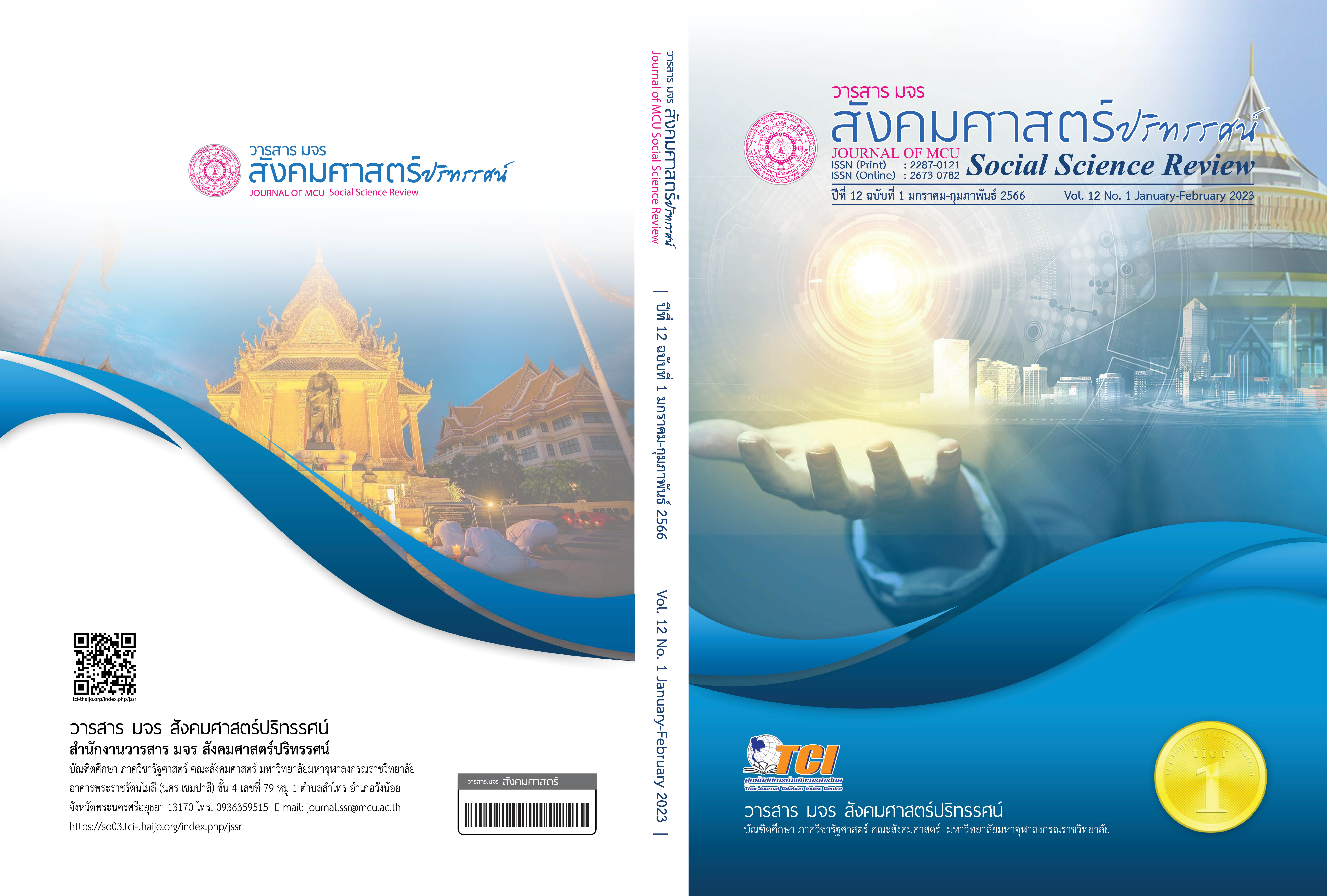การประยุกต์ใช้หลักพุทธธรรมสัปปุริสธรรม 7 ในการพัฒนาทุนมนุษย์ยุค AI ภายใต้การทำงานแบบปกติใหม่
คำสำคัญ:
สัปปุริสธรรม 7, ทุนมนุษย์, การทำงานแบบปกติใหม่บทคัดย่อ
บทความนี้เป็นบทความวิชาการที่มุ่งประเด็นให้องค์กรต่าง ๆ เล็งเห็นถึงความสำคัญของการพัฒนาทุนมนุษย์ท่ามกลางการเปลี่ยนแปลงทั้งด้านเศรษฐกิจ สังคม และการนำเทคโนโลยีหรือปัญญาประดิษฐ์เข้ามาใช้รวมถึงสถานการณ์โควิด-19 โดยมีแนวคิดที่ว่าองค์กรหรือหน่วยงานใดมีทุนมนุษย์ที่มีศักยภาพพร้อมรับมือกับการเปลี่ยนแปลง ย่อมเกิดความได้เปรียบทางธุรกิจ ซึ่งเป็นปัจจัยส่งเสริมให้องค์กรบรรลุเป้าหมายตามกลยุทธ์ที่วางไว้ การพัฒนาทุนมนุษย์โดยการการอบรมพนักงานแบบใหม่ที่ใช้เทคโนโลยีหรือปัญญาประดิษฐ์เข้ามาเสริมนั้น ถือเป็นส่วนหนึ่งในการช่วยพัฒนาองค์กรที่เหมาะสมในสภาวการณ์ทำงานแบบปกติใหม่เช่นนี้ประกอบกับการเตรียมความพร้อมในการพัฒนาทุนมนุษย์ตามหลักสัปปุริสธรรม 7 ซึ่งเป็นธรรมะที่ช่วยขัดเกลาคนธรรมดาให้กลายเป็นคนที่พึงปรารถนาของสังคม เฉกเช่นเดียวกับการพัฒนาทรัพยากรมนุษย์สู่การเป็นทุนมนุษย์ที่มีศักยภาพขององค์กร ประกอบไปด้วย 1) ธัมมัญญุตา ความเป็นผู้รู้จักเหตุ 2) อัตถัญญุต ความเป็นผู้รู้จักผล 3) อัตตัญญุตา ความเป็นผู้รู้จักตน 4) มัตตัญญุตา ความเป็นผู้รู้จักประมาณ 5) กาลัญญุตา ความเป็นผู้รู้จักกาล 6) ปริสัญญุตา ความเป็นผู้รู้จักชุมชน และ 7) ปุคคลัญญุตา ความเป็นผู้รู้จักบุคคล องค์ประกอบทั้ง 7 ประการนี้ ถือเป็นขั้นตอนสำคัญในการเรียนรู้ วางแผน และเตรียมความพร้อมสำหรับองค์กรได้เป็นอย่างดี เพื่อให้ได้ความต้องการที่ถูกต้อง และสร้างวิธีการพัฒนาที่เหมาะสม พร้อมรักษาบุคลากรหรือทุนมนุษย์ที่เป็นทั้งคนเก่งและคนดี ให้คงอยู่คู่กับองค์กร และเติบโตได้อย่างยั่งยืนตลอดไป
เอกสารอ้างอิง
กิตติ มิลำเอียง. (2559). การสรรหาและคัดเลือกทรัพยากรมนุษย์ในองค์การภาครัฐยุคใหม่. วารสารมนุษยศาสตร์ และสังคมศาสตร์ มหาวิทยาลัยราชภัฏสุราษฎร์ธานี, 8(1), 149.
ดาวิษา ศรีธัญรัตน์. (2562). ระบบงานทรัพยากรมนุษย์เชิงกลยุทธเพื่อการพัฒนาองค์การ. กรุงเทพฯ: สถาบันบัณฑิตพัฒนบริหารศาสตร์.
ประชาชาติธุรกิจ. (2561). HR Tech 2018 ขับเคลื่อนทุนมนุษย์ด้วยเทคโนโลยี. สืบค้นเมื่อ 10 ตุลาคม 2564, จาก https://www.prachachat.net/csr-hr/news-148839.
โปรซอฟท์ เอชซีเอ็ม. (2561). องค์กรยุคใหม่ พัฒนาทุนมนุษย์ 3 ด้าน. สืบค้น 14 ตุลาคม 2564, จาก http://www.prosofthcm.com/Article/Detail/16738.
พระพรหมคุณาภรณ์ (ป.อ.ปยุตโต). (2551). การพัฒนาที่ยั่งยืน (พิมพ์ครั้งที่ 11). กรุงเทพฯ: มูลนิธิโกมลคีมทอง.
พฤทธิพงศ์ จักกะพาก. (2564). การพัฒนาทุนมนุษย์ตามแนวทางรัฐประศาสนศาสตร์. วารสารสังคมศาสตร์ปริทรรศน์, 10(2), 361-362.
ราชบัณฑิตยสถาน. (2546). พจนานุกรมฉบับราชบัณฑิตยสถาน พ.ศ. 2542. กรุงเทพฯ : นานมีบุ๊คส์พับลิเคชั่นส์
สำนักงานคณะกรรมการพัฒนาการเศรษฐกิจและสังคมแห่งชาติ. (2560). แผนพัฒนาเศรษฐกิจและสังคมแห่งชาติ ฉบับที่ 12. กรุงเทพฯ: สำนักงานนายกรัฐมนตรี.
Barney, J. B. (1991). Firm Resources & Sustained Competitive Advantage. Journal of Management, 17(1), 99-120.
Graton, L. & Ghoshal S. (2003). Managing Personal Human Capital: New Ethos for the “Volunteer” Employee. European Management Journal, 21(1), 1-10.
Marquardt, M.J. (1996). Building the Learning Organization: A Systems Approach to Quantum Improvement and Global Success. New York: McGraw-Hill.
ดาวน์โหลด
เผยแพร่แล้ว
รูปแบบการอ้างอิง
ฉบับ
ประเภทบทความ
สัญญาอนุญาต
ลิขสิทธิ์ (c) 2023 วารสาร มจร สังคมศาสตร์ปริทรรศน์

อนุญาตภายใต้เงื่อนไข Creative Commons Attribution-NonCommercial-NoDerivatives 4.0 International License.
เพื่อให้เป็นไปตามกฎหมายลิขสิทธิ์ ผู้นิพนธ์ทุกท่านต้องลงลายมือชื่อในแบบฟอร์มใบมอบลิขสิทธิ์บทความให้แก่วารสารฯ พร้อมกับบทความต้นฉบับที่ได้แก้ไขครั้งสุดท้าย นอกจากนี้ ผู้นิพนธ์ทุกท่านต้องยืนยันว่าบทความต้นฉบับที่ส่งมาตีพิมพ์นั้น ได้ส่งมาตีพิมพ์เฉพาะในวารสาร มจร สังคมศาสตร์ปริทรรศน์ เพียงแห่งเดียวเท่านั้น หากมีการใช้ภาพหรือตารางหรือเนื้อหาอื่นๆ ของผู้นิพนธ์อื่นที่ปรากฏในสิ่งตีพิมพ์อื่นมาแล้ว ผู้นิพนธ์ต้องขออนุญาตเจ้าของลิขสิทธิ์ก่อน พร้อมทั้งแสดงหนังสือที่ได้รับการยินยอมต่อบรรณาธิการ ก่อนที่บทความจะได้รับการตีพิมพ์ หากไม่เป็นไปตามข้อกำหนดเบื้องต้น ทางวารสารจะถอดบทความของท่านออกโดยไม่มีข้อยกเว้นใดๆ ทั้งสิ้น





